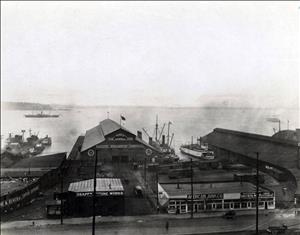On April 26, 1944, fire suddenly erupts on Pier D (Pier 46), leased by the Luckenbach Steamship Company, menacing Seattle’s busy wartime waterfront. Alert dock workers see smoke and flames emanating from the second floor at the outer end of the terminal warehouse and rush to send in the alarm. Seattle Fire Chief William T. Fitzgerald (1891-1976) immediately dispatches all available firefighting apparatus and personnel to the scene and the blaze is under control in less than half-an-hour. Fortunately there are no vessels at the pier and little cargo in the transit shed at the time. There are no injuries and damage to the facility is estimated at approximately $50,000. It is the first major fire to hit the Seattle waterfront since the fire which severely damaged the Union Pacific Dock (Pier 44) on July 17, 1929.
Vital to the War Effort
Pier D (redesignated Pier 46), at the foot of King Street, was built in 1901 by the Pacific Coast Company. It was one of four large docks, designated Piers A through D, that the Pacific Coast Company used in its coal mining, steamship, and rail operations in King County.
During World War II (1941-1944), Pier D was leased to the Luckenbach Steamship Company, a major force in express freight and passenger service between West Coast ports and East Coast and Gulf ports. Units of Washington State Guard soldiers were billeted at various locations along Seattle’s waterfront to guard the vital installation against saboteurs.
Smoke and Flame
At approximately 1:00 p.m. on Wednesday, April 26, 1944, dock workers spotted smoke and flames shooting from the second floor at the west end of the Pier D terminal warehouse and turned in the alarm. A stiff onshore breeze stoked the fire and within minutes it appeared as though the entire 600-foot facility was ablaze.
Seattle Fire Chief William T. Fitzgerald immediately sent out a general alarm which brought 12 engine companies, four truck companies, two fireboats, the Duwamish and Alki, and two U.S. Coast Guard firefighting barges rushing to the scene. These forces were augmented by more than 200 Coast Guardsmen and volunteer auxiliary firefighters from around the city. Men with fire hoses were stationed on the roofs of adjacent buildings to prevent flames from spreading to other vulnerable structures on the waterfront. The response time was so quick that the blaze was under control in less than a half-hour. Within an hour, the fire was declared “tapped out” and firefighters spent the remainder of the afternoon conducting mopping-up operations.
Downtown Seattle came to a standstill as thousands of spectators gathered on city streets and atop office and apartment buildings to watch great clouds of black smoke billowing skyward and the fireboats Duwamish and Alki stream water onto the roof of the warehouse. Traffic on the busy waterfront was blocked for more than an hour as the firefighters battled the blaze.
Fire Chief Fitzgerald, who directed the firefighting operation, said the blaze apparently started in the living quarters of Washington State Guard soldiers assigned to Pier D. The exact cause was not determined, but fire investigators believed it to have been caused by an electric hot plate or oil heater. Fortunately, there were no freighters moored at the dock and minimal cargo in the warehouse. The major damage occurred in a 150-foot section at the west end of the dock building, but damage was evident along a wide expanse of roof through which the fire erupted. Chief Fitzgerald estimated damage to the terminal to be approximately $50,000.

